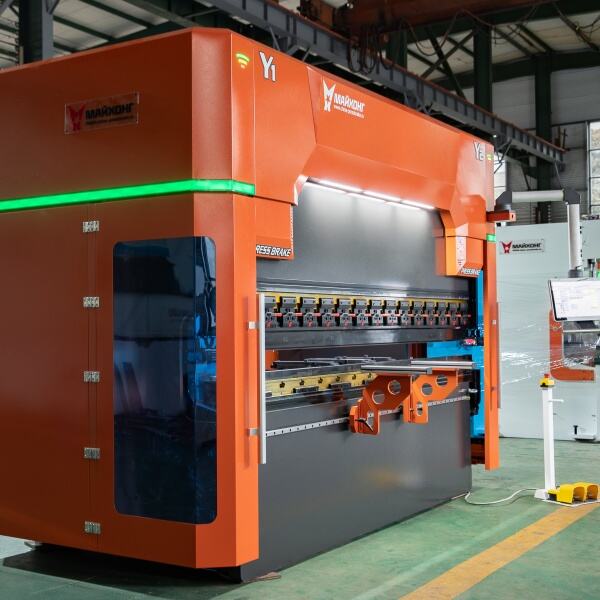Günlük ve Haftalık Bakım Rutinleri
Artık Maddelerin Temizliği için Prosedürler
CNC hidrolik pres bükme makinesi gibi hidrolik pres bükme makinesinin ömrünü uzatmak adına düzenli temizlik çok önemlidir. Aşırı aşınmaya yol açabilecek önemli hareketli parçaları her gün temizleyebilirsiniz. Bu işlem sadece hidrolik pres bükme makinesinin ömrünü uzatmakla kalmaz, aynı zamanda verimliliğin maksimum seviyede tutulmasına da yardımcı olur. Contaları ve hidrolik komponentleri zararlamayacak uygun temizlik malzemelerini içeren bir temizlik listesi oluşturmak da oldukça önemlidir. Temizlik sıklığı ve hedeflenen alanlar ile ilgili net bir kayıt tutarak hem tutarlı hem kapsamlı bir bakım programı izleyebilirsiniz. Bu da beklenmedik arızaların ve maliyetli ekipman sorunlarının riskini en aza indirger.
Hidrolik Yağ Seviyesi ve Kalite Kontrolleri
CNC pres bükme makinenizin bakımını yapın. CNC pres bükme makinesinin hidrolik yağını kontrol edin. Kirlilik veya renk değişikliği, küller ya da viskozitede herhangi bir anormallik varsa izolasyonun genel sağlığının bir şekilde bozulmuş olma ihtimali vardır, bu nedenle düzenli kontroller gerekli hale gelir. Her kontrolün kaydedilmesi, ileride ortaya çıkabilecek daha büyük sorunları önceden gösteren eğilimlerin belirlenmesine olanak tanır. Ayrıca, hidrolik yağın ne zaman değiştirileceğine dair açık politikalar uygulamak, ileride oluşabilecek pahalı sistem sorunlarından kaçınmanıza yardımcı olabilir. Bu ipuçlarını uygulayarak operasyonlarınızın kesintisiz bir şekilde devam etmesini sağlayabilir ve pahalı ve beklenmedik onarımların önlenmesiyle CNC pres bükme makinesini maliyet açısından daha etkili hale getirebilirsiniz.
Kritik Bileşenlerin Görsel Kontrolü
Ağır Hizmet Parçalarını Kontrol Edin – Bir CNC hidrolik pres bükme makinesini çalışır durumda tutmayı planlıyorsanız, silindirler, valfler ve hortumlar gibi kritik sistemlerin haftalık görsel kontrolleri zorunludur. Bu parçaları dikkatli bir şekilde kontrol ederek aşınma, sızıntı veya hasar belirtilerini fark edebilir ve potansiyel sorunları ciddi hale gelmeden önce müdahale edebilirsiniz. Standart bir kontrol listesi, tüm elemanların eşit şekilde değerlendirilmesini sağlar ve sonuçların detaylı bir rapor süreciyle takip edilmesi, aynı zamanda hemen harekete geçilmesine olanak tanır. Bu süreç sayesinde makinenin verimliliğini ve ömrünü artırabilirsiniz; bu da etkili ve güvenli bir şekilde nasıl çalıştırılacağını bilmek için yapılan yatırımı destekler.
Hidrolik Pres Bükme Makineleri için Yağlama Stratejileri
CNC Hidrolik Sistemler için Optimal Gres Türleri
Doğru greft (yağ) seçimi, CNC hidrolik sisteminizin uzun süre ve sorunsuz çalışması için önemlidir. Üretici tarafından belirlenen önerilerin eşit ya da üzerinde bir kaliteye sahip bir greft (yağ) seçmek önemlidir. Optimal seçim, makinenin çalışma sıcaklığı ve basıncı gibi parametrelere göre büyük ölçüde değişiklik gösterebilir. İhtiyacınıza cevap veren ve vazgeçilmez ürünler olduğunu düşünmenizi öneririm. Örneğin, otomatik dağıtıcılar greftin (yağın) iyi bir uzunlamasına dağılımını sağlayabilir. Doğru greft (yağ) ve uygun lubrikasyon (yağlama) tekniği kullanımı, hidrolik Pres Bükme makinenin sorunsuz ve güvenilir çalışmasını sağlamak için oldukça faydalıdır.
Fazla Yağlamadan Kaçınmak
Aşırı yağlama da ortaya çıkabilecek bir sorundur ve parçaların arızalanmasına neden olabilir. Böyle sorunlardan kaçınmak için resmi kılavuzlar hazırlayın. Yağlama sıklığını ve miktarını izlemek, aşırı yağlamayı önlemenin bir yoludur. Ayrıca, bu yöntemin sonucunda hidrolik sistemlerin ömrü uzarken performans da korunur. Operatörleri, aşırı yağlamanın belirtileri konusunda bilgilendirerek bu sorunlardan kaçınmak mümkündür. Periyodik olarak yağlamanın etkinliğinin sıkı sıkıya denetlenmesi ve değerlendirilmesi de uygun düzeltmeleri yapmak ve ilgili makinenin ideal düzeyde çalışmaya devam etmesini sağlamak açısından çok önemlidir.
Ana Parçaların Aşınma ve Bakım İçin Denetlenmesi
Fren Balatalarının ve Hizalama Sistemlerinin Değerlendirilmesi
Fren balatalarının ve hizalamanın kontrol edilmesi, CNC hidrolik pres fren makinesinin güvenli ve daha iyi çalışmasını sağlamak açısından hayati öneme sahiptir. Balatalar periyodik aralıklarla aşınma açısından kontrol edilmeli ve boşluk kalmadan kasnağa oturduklarından emin olunmalıdır. Aşınma limitlerine ilişkin üretici belirtelere uyulması, parçanın ne zaman değiştirilmesi gerektiğini belirlemede de yardımcı olur; bu da arızaların önlenmesine olanak tanır. Hizalama kontrolü sırasında kullanılacak hassas aletler, makinenizin doğru ve güvenli çalışmasını sağlayacaktır. Diğer yandan periyodik kontrollerin yapılmaması, maliyetli onarımlara ve hatta arızalara neden olabilir.
Hidrolik Hortum Bütünlüğü Testi
Hidrolik hortumların düzenli olarak test edilmesi, durumlarını ve iyi çalışıp çalışmadığını belirlemek için de önemlidir. Gerilim testleri yaparak çatlakları, kıvrılmaları, sızıntıları ve hortumların gücünü ve güvenliğini tehlikeye sokan sertleşmeleri tespit edebiliyoruz. Planlanmamış arızalardan kaçınmak için üreticinin önerilerine uygun olarak belirlenmiş değiştirme aralıklarına sahip olmak önemlidir. Test sonuçlarını belgelenmiş şekilde oluşturursak CNC hidrolik pres bükme makinesinin güvenliği ve erişilebilirliği önemli ölçüde artacaktır.
CNC Kontrol Paneli Diyagnostiği
CNC Kontrol Paneli Tanısal Analizleri Periyodik kontrol paneli kontrolleri, kontrollerinizi en yüksek performansta tutmak için önemlidir. En son yazılım araçlarının gücüyle, sorunlar üretim durmasına veya güvenlik tehlikesine dönüşmeden önce tespit edilebilir. Teknisyenlerin tanısal analizleri yorumlamada iyi eğitilmiş olması, proaktif bakım süreçlerinin sorunsuz bir şekilde yürütülmesini sağlar. Kontrol yazılımının düzenli olarak güncellenmesi, atölyenin en yeni geliştirmelerden ve en son güvenlik önlemlerinden yararlanmasını sağlayarak pres kırma sistemlerinin genel güvenilirliği ve performansına katkıda bulunur.
Kalibrasyon & CNC Sistem Bakımı
Arka Ölçü Doğruluk Ayarları
Pres bükme makinelerinin arka mastarının doğruluğunu korumak, CNC sisteminin hayati bir parçasıdır. Metal şekillendirme işleminin doğruluğunu sağlamak adına her servis aralığında düzenli olarak kontrol yapılması çok önemlidir. Kalibre edilmiş ölçüm cihazlarımızla belirlenen toleranslara göre inanılmaz derecede hassas şekilde konumlandırma yaparak üretim süreçlerimizin sürekliliğini garanti altına alıyoruz. [Bu komutu vermek], yaptığınız değişiklikleri takip etmek ve eğer gerekirse [bu işlemi geri] almak için iyi bir yöntemdir. (Operatörlerinizi, arka mastar ayarlarının doğru yapılması konusunda eğiterek genel verimlilik ve nihai ürün kalitesi açısından fark yaratabilirsiniz).
Modern Pres Bükme Makineleri için Yazılım Güncellemeleri
Daha yeni pres kılavuzundan en iyi şekilde yararlanmak ve çalışma süresini azaltmak için kontrol yazılımınızı güncellemek çok önemlidir. Üreticiden gelen güncellemeleri sürekli takip ederek yeni özelliklerden ve güvenlik önlemlerinden faydalanmanız sağlanır. Ayrıca, sahip olduğunuz yazılım sürümlerini belgelemek uygunluk ve hesap verebilirlik açısından hayati öneme sahiptir. Yeni yazılım özellikleri konusunda operatörlere eğitim verilmesi, sorunsuz bir yükseltme süreci ve operasyonel verimliliğin artırılması ile öğrenme eğrisinin minimize edilmesine yardımcı olur.
Pahalı Onarımları Önlemek İçin Proaktif Bakım
Yıllık Hidrolik Yağ Değişimi
Yıllık hidrolik sıvı yenileme işlemi, CNC pres bükme makinelerinin ideal özelliklerini korumak için önemlidir. Bu değişiklikler, hidrolik sistemin ömrünü uzatmak, beklenmedik arızaları azaltmak ve pahalı onarımlardan kaçınmak amacıyla planlanır. Uygunluk ve ileride referans olması için tarihler ve sıvı tipleri kayıt altına alınmalıdır. Dahası, çalışanlarımızı hidrolik sıvı kalitesinin değerine ve bunun sistemin performansı ile ömrüne etkisine dair bilgilendirmemiz gerekir. Bu şekilde hareket ederek makinenin nasıl çalıştığını izlemek, arıza durumunda daha sık değişiklik yapılması gerektiğini gösterebilir; potansiyel sorunların farkında olunması ise kesinlikle ihmal edilmemelidir.
Güvenlik Protokolü Uygulaması
Hidrolik pres bükme makinesinin kullanımı sırasında güçlü güvenlik prosedürlerinin oluşturulması, güvenli çalışma koşulları için hayati öneme sahiptir. Sektörel standartlara ve mevzuata uygunluğun sağlanması ile operasyonel risklerin azaltılması amacıyla düzenli güvenlik denetimleri gereklidir. Aynı derecede önemli olan diğer husus ise çalışanların kapsamlı bir şekilde eğitilmesidir; bu eğitimler sırasında güvenlik kuralları ve acil durumlarda yapılması gerekenler aktarılır. Yayınlanmış olaylar, ilgili tüm taraflar için çalışma ortamının güvenliğini artırmak ve bu tür olayların yönetimini optimize etmek amacıyla uygulanabilir.
Operatör Eğitimi En İyi Uygulamaları
Hidrolik pres bükme makinesi operatörlerinin nasıl çalıştırılacağını öğrenmek için resmi bir operatör eğitimi programı geliştirmek hayati öneme sahiptir. Bu tür girişimler, öğrenmeyi ve bilgilerin kalıcılığını desteklemek amacıyla teorik eğitimin yanı sıra pratik, saha içi deneyimi de içermelidir. Eğitim materyalleri güncel tutulmalı ve operatörlerin, CNC operasyonu konusundaki en son teknolojiler ve gelişmeler konusunda bilgilendirilmesi sağlanmalıdır. Sürekli değerlendirmeler ve yenileme kursları, operatörlerin etkinlik ve yeterlilik seviyesini yüksek düzeyde tutmada kritik rol oynar.



